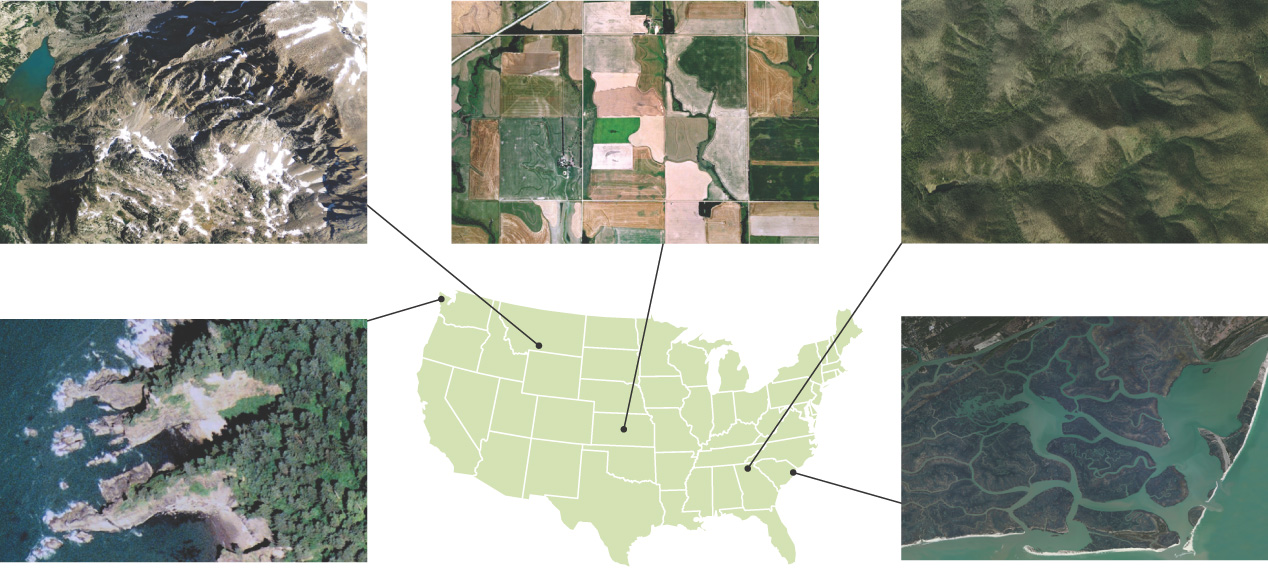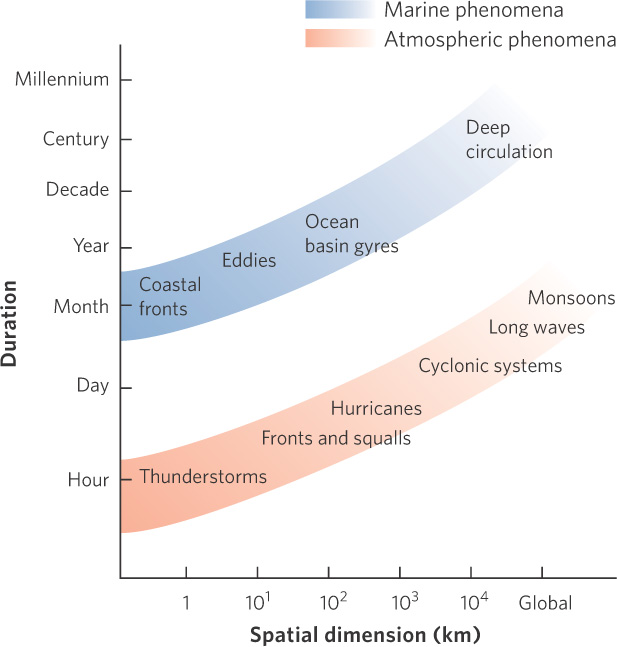Ecological systems and processes vary in time and space
Most properties of the environment change over time and across space, and they can change at different rates. For example, air temperature can plunge dramatically in a matter of hours as a cold front passes through a region. On the other hand, ocean water may require weeks or months to cool the same amount. In this section we will look at temporal and spatial variation in the environment, and then bring them together to see how they are related.
87
Temporal Variation
Weather The variation in temperature and precipitation over periods of hours or days.
Temporal variation in the environment describes how environmental conditions change over time. Some temporal variation is predictable, including alternation of day and night and seasonal changes in temperature and precipitation. Superimposed on these predictable cycles are irregular and unpredictable variations, including weather and climate. Weather refers to the variation in temperature and precipitation over periods of hours or days. Climate refers to the typical atmospheric conditions that occur throughout the year, measured over many years. For example, the climate of Wyoming is typically cold and snowy in the winter but hot and dry in the summer. However, the weather on any particular day cannot be predicted very far in advance; it can vary over intervals of a few hours or days with the movement of cold and warm air masses. Although climate describes the average conditions of a given location throughout the year, climate also can vary over long periods of time. For example, a location might experience a string of years that are much wetter or drier than the average year.
Climate The typical atmospheric conditions that occur throughout the year, measured over many years.
Some types of temporal variation can cause large impacts on ecosystems but occur infrequently in a particular place. For example, droughts, fires, tornadoes, and tsunamis can cause major changes in the landscape, yet their frequency at a particular location is rare. The massive tsunami that hit Japan in 2011, for example, was of a magnitude that has not been seen in more than a hundred years (Figure 4.1). Other sources of temporal variation, such as the current warming of Earth, occur very slowly over decades and centuries.

Some ecosystems can experience temporal variation at fairly regular intervals. In pine woodlands, for example, pine needles and twigs accumulate over time, increasing the probability of a destructive fire as the time since the last fire increases, and contributing to the occurrence of forest fires at fairly regular intervals. Similarly, communicable diseases can spread through a population at regular intervals. After an initial exposure to a disease, many individuals develop immunity. However, as new individuals who lack immunity are produced or join the community, the disease can appear in the population once again. As a result, disease prevalence fluctuates over time every few years. In such cases, the temporal variation in the environment has a fairly regular cycle.
How organisms and populations respond to temporal variation in their environment depends on the severity of the change and how often it occurs. In general, the more extreme the event, the less frequently it occurs. However, both the severity and the frequency of events are relative measures; they depend on the organism that experiences them. Forest fires that occur every 20 years can affect a long-lived tree numerous times, but may only affect one out of 20 generations of an insect that has a one-year lifespan.
Spatial Variation
Environmental variation also occurs from place to place. Variations in climate, topography, and soil type cause large-scale heterogeneity (Figure 4.2). If you were to fly across the United States from Oregon to South Carolina, for instance, you would observe a series of major, large-scale environmental changes along the trip: the rocky western coast, northwestern forests, western rangelands, midwestern agricultural fields, eastern forests, and coastal beaches. At smaller scales, environmental variation is generated by the structures of plants, the activities of animals, the composition of soil, and the activities of humans. As with temporal variation, a particular scale of spatial variation may be important to one organism but not to another. The difference between the top and the underside of a leaf, for example, is important to an aphid, but not to a moose, which happily eats the whole leaf, aphid and all.

88
Moving through environments that vary in space, an individual experiences environmental variation as a sequence in time. In other words, a moving individual perceives spatial variation as temporal variation. The faster an individual moves and the smaller the scale of spatial variation, the more quickly the individual encounters new environmental conditions and the shorter the temporal scale of the variation. This principle applies to plants as well as to animals. For example, as plant roots grow, they push their way through the soil, and soils commonly contain small-scale variation in moisture and nutrients. If a plant’s roots grow quickly in soil with a fine scale of variation, the plant roots will frequently encounter new soil environments. Similarly, wind and animals disperse the seeds of plants. The variety of habitats in which the seeds might land depends on the distance the seeds travel and the scale of spatial variation in the habitat.
Correlation of Spatial and Temporal Dimensions
Scientists have observed that the extent of the space affected by an event is usually positively related to an event’s duration in time. Looking at Figure 4.3, we see that thunderstorms typically affect relatively small areas and last only a few minutes, whereas hurricanes inflict devastation across hundreds of kilometers and last for days or weeks. Similar patterns can be observed in the oceans. Eddy currents, which are circular ocean currents that span 100 to 200 km, may last only a few days. Ocean gyres, which are large currents that circulate between continents, can last several years. Deep circulation, which involves currents that mix all of the world’s oceans, lasts for hundreds of years.

89
Topography and geology are transformed at a very slow pace by such processes as mountain building, volcanic eruptions, erosion, and even continental drift. Variations in landforms have very long temporal scales. In contrast, spatial heterogeneity in the open ocean is the result of physical processes in water that change more quickly than those in rock and soil. Because air is even more fluid than water, atmospheric processes have very short time scales at any given spatial scale.